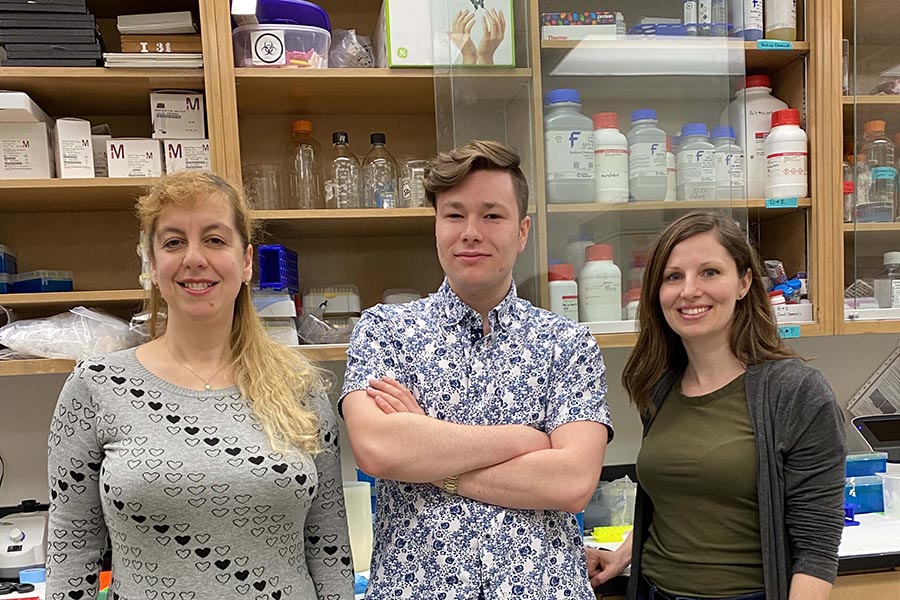
USask researchers training fungi to sense radiation and potentially help clean up nuclear waste
SASKATOON – University of Saskatchewan (USask) researchers have demonstrated that it is possible to “train” microscopic black fungi in the lab to find radiation sources—a discovery with potential applications such as cleaning up radioactive waste from nuclear accidents and detecting radioactive fallout from illicit nuclear testing.
By USask Research Profile and ImpactIn a recent paper published in Fungal Biology, USask radiochemist Ekaterina Dadachova and her team have shown that fungi that have been “radio-adapted”—exposed for a protracted period to a mixed field of normally harmful ionizing irradiation—can “sense” subsequent high-dose radiation, resulting in increased growth of the fungi colonies.
Essentially the fungi “eat” the radiation, possibly by converting it into a usable energy source that then directs their growth.
“Let’s say that there are suspicions of some kind of illicit nuclear activity going on somewhere—an underground nuclear test without notification, for instance,” said Dadachova, who holds the Fedoruk Centre for Nuclear Innovation Chair in Radiopharmacy at USask.
“We wanted to see whether we could train our fungi to recognize certain types of radioactive nuclides. This potentially would turn these fungi into cost-effective and highly sensitive biological detectors of nuclear fallout,” said Dadachova. “And because the fungi grow in response to radiation, they could envelop microscopic particles, preventing the radioactivity from leaching into the ground. So potentially we could use these radio-adapted fungi for bioremediation of radioactive sites to clean up nuclear contamination.”
It is well-known that some species of fungi have the unique ability to not only survive in a radioactive environment on Earth or in space, but actually thrive despite radioactive contamination and limited nutrients. Dadachova’s work over the past 15 years has focused on trying to understand how this happens.
In the early ‘90s, when the site in Ukraine of the 1986 meltdown of the Chernobyl nuclear reactor was opened up to researchers, Ukrainian scientists noticed that the contaminated soils around the Chernobyl power plant were turning black due to the presence of fungi which had managed to survive the nuclear disaster. What they found was that the fungi that had been previously exposed to ionizing (harmful) radiation at Chernobyl grew toward radiation sources—but they didn’t know why or how this occurred.
Then, in a seminal paper in 2007, Dadachova’s group was the first to pose the question of whether the answer lies with melanin, a dark pigment prevalent in these fungi that is similar to the pigment that makes human skin dark. Melanin’s ability to convert energy from ionizing radiation into usable chemical energy—which Dadachova proposed in her 2007 paper—was later confirmed by Zheng Wang’s group at the U.S. Naval Research Laboratory.
Further research from Dadachova’s lab in the following decade provided experimental evidence that melanin, extracted from fungi and plants or produced chemically, can also be used as a radioprotector for cancer patients, military personnel, and astronauts (a project currently funded by the Canadian Space Agency), as well as for shielding sensitive equipment from radiation.
However, until now, researchers have not been able to create in the lab radio-adapted fungi strains in which response to radiation would be the same as observed in the Chernobyl strains.
By exposing the micro-fungi to the same radiation dose as had been the case with Chernobyl fungi, her team has shown that the radio-adapted fungi do not just grow in the presence of radiation but sense radiation through melanin in their cell walls, improving the fungi’s ability to withstand ionizing radiation.
The team examined the effects of ionizing radiation on the growth of both fungi containing melanin and a control group of a mutant form of the same fungus not able to produce melanin. The role of melanin was confirmed when the melanin-deficient control group did not show the same growth increases when exposed to the same levels of radiation.
“The trick was that the fungi samples needed to be exposed to mixed radiation—alpha, beta and gamma—because that’s what is in nuclear fallout. First, we tried to expose them just to beta radiation and then just to gamma radiation,” said USask lab manager Mackenzie Malo, first author on the paper.
“But then we decided to imitate what was probably going on in the Chernobyl-contaminated soil where there was mixed radiation. When we combined all three forms, all of a sudden the fungi learned how to sense radiation through interaction of melanin with the radiation. We managed to ‘train’ the microscopic fungi, a uni-cell organism, to respond to the radiation.”
The research, funded by the Defense Threat Reduction Agency of the U.S. Department of Defense, was done in Dadachova’s lab at the USask College of Pharmacy and Nutrition. Her team also included undergraduate biochemistry student Connor Frank. Zheng Wang from the U.S. Naval Research Laboratory is a co-principal investigator on the grant.
The next step is to analyze, working with Wang, the genetic make-up of the trained fungi to determine whether there have been changes to the genome of the fungi strains from the radio-adaption process.
“By combining our knowledge of the way melanin senses and protects against radiation, we hope to develop applications that could protect patients undergoing cancer therapy from side effects of radiation or protect astronaut flight crews exposed to high levels of cosmic radiation, as well as develop a way to convert radiation into usable energy forms,” said Dadachova.
The paper is available here: https://www.sciencedirect.com/science/article/pii/S187861461930159X
-30-
For more information, contact:
Victoria Dinh
Communications and Media Relations Co-ordinator
University of Saskatchewan
306-966-5487
victoria.dinh@usask.ca
